 The Biking Life
The Biking Life
by: Naomi Bloom 4/1/2003
Over the Creek and Under the Freeway
The last Saturday in March I pedaled 2.5 miles to attend a ribbon-cutting ceremony for the second bicycle- pedestrian bridge in my home town. This little crossing of Saratoga Creek connects with an equally new linking Santa Clara and San Jose -- or at least it will, once the rest of the planned trail system is built.
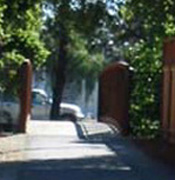
The entire trail and adjacent creek crossings will run from San Francisco Bay at San Tomas Creek in Santa Clara to Prospect Road on the border between San Jose and Saratoga. It's been mapped out in "reaches" numbering from 1, at the Bay, to 6, at Prospect. Cupertino's own Reach 5 is the first to be completed.
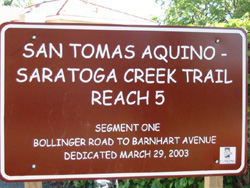 Although not much more than a promise of something more practical, the Saratoga Creek Reach 5 bridge is a beauty. It's easy to approach, smooth as concrete to ride (because it is concrete) and nice to look at.
Although not much more than a promise of something more practical, the Saratoga Creek Reach 5 bridge is a beauty. It's easy to approach, smooth as concrete to ride (because it is concrete) and nice to look at.
If only there were hundreds more like it. But my personal experience with California bike bridges, as well as highway overcrossings and undercrossings, hasn't come up with many. It's just amazing how these so-called "facilities" have taken advantage of ISTEA and other public funding, when most of them don't "facilitate" riding a bike at all.
Cross over that bridge
Take the bike bridges in Palo Alto. Please. You know, Palo Alto, the "bicycle-friendly city"? Well-marked bike lanes and traffic light sensors. A dedicated "Bicycle Boulevard." And half a dozen bike-ped bridges that cross the local creeks. Yet it took Palo Alto over two decades to figure out that wood is not an optimal material for a bridge surface. Wood warps, resulting in a most unhealthy rattling of bike and body parts.Thank goodness, they finally got the message and began putting in concrete bridge surfaces. The nicest one spans San Francisquito Creek between Alma Avenue in Menlo Park and Palo Alto Blvd. But my teeth still rattle on the wood planks on the bridges connecting with Mountain View and Los Altos.
Apparently not all boardwalk bridges are subject to such deterioration. My fellow columnist Bill O. sings the praises of the wooden bridge on the West Sonoma County Trail. "I ride it two or three times a month," he says, "and it does what it's supposed to do: transits the wetland of Atascadero Creek without making a massive footprint. The whole bridge and the gravel section do go underwater occasionally in the wet season, but so far have not appeared any the worse for the experience."
A bridge too high, steep and inaccessible
Bridges over creeks, however -- even wooden ones -- are paradise compared to the common CalTrans concept of a freeway overcrossing. Most of these suckers feature grades that rival the International Cycling Union's "hors categorie," with switchbacks that make l'Alpe d'Huez look like a cakewalk. (OK, OK, I exaggerate. That's not the real problem, anyway.)What really bugs me is the limited access to these engineering blunders. Like the one I encountered last month while riding across San Jose. Zipping down a residential street, I headed straight for the overcrossing entrance. Suddenly I realized there was a rougly nine-inch curb between my front wheel and the entrance! Quick change of direction called for! Dodge to the right and onto a private driveway. Sharp left onto the sidewalk. Even sharper right into the entrance, taking care not to smash into the post barring motor traffic. Who has time to downshift to get up that 6-percent grade?
Even worse, I have a particular affliction when it comes to sharp right turns. I simply can't do them, at least not the ones sharper than about 80 degrees. It may have something to do with my inherently lousy depth perception. And I know I'm not alone; many fellow cyclists have confessed a similar problem.
This particular San Jose overcrossing isn't the only one I've had to tangle with. Here are a few more examples from my home turf on the Peninsula and in the South Bay:
- Palo Alto: Over U.S. 101 from Oregon Expressway to East Bayshore
This little number has the same kind of sharp turn onto a sidewalk as previously mentioned. It also features full-length barriers that force riders off their bikes. So why is this a "bike" overpass? - Belmont:Over CA 92 from Ralston Avenue to Canada Road
There's no view of the westbound grade, which must exceed 9%, until you're almost on top of it. Headwinds and/or crosswinds can be brutal. And it ices up on cold winter mornings (right, Jo?). - Campbell:Over San Tomas Expressway at Rincon Ave.
This one features the CalTrans-standard high curb, sharp turns and steep grades. But it's easy to get around on surface streets that cross the expressway. Why is it even there? - Saratoga:Over CA 85 from Scully Ave./Kevin Moran Park to Goleta Ave./Azule Park
This is a great overcrossing. No steep grades. Easy approaches on both sides. It's a breeze. Or at least it was, until the City of Saratoga dug up the approach on the Goleta side and left it impassable.
There is hope for newer, more bike-friendly overcrossings, however. A quick Web search yields information, plans, designer concepts, photos, etc. for the Iron Horse Trail Crossing in Contra Costa County and an I80 crossing in Berkeley.
There are even a few newer, decent overcrossings on my side of the Bay, like the one over Central Expressway and CalTrain tracks in Mountain View. This is a wonderful overpass! Wide, well-angled switchbacks on both uphill approaches. Great signage. Good ramping. Perfect visibility.
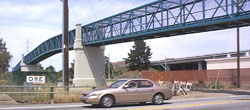
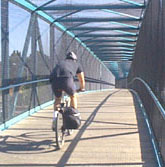 So why, oh why am I still stymied by the sharp right turns you can't see in these photos? I cringe every time I have to cross it on the Stevens Creek Trail.
So why, oh why am I still stymied by the sharp right turns you can't see in these photos? I cringe every time I have to cross it on the Stevens Creek Trail.
One more hopeful: At long last there's a bid proposal out for the Mary Avenue crossing over I280 between Cupertino and Sunnyvale. I sure do hope the Valley Transportation Authority and City of Cupertino take a long look at the approaches on both ends in order to provide decent grading and ramping.
When you can't cross over, try tunneling under
Then there are the bike-pedestrian undercrossings. Rarer than flying buttresses over freeways, these also have their good -- and bad -- points. For instance:- Palo Alto: Under CalTrain tracks at California Avenue
A geographically logical connection between the Bike Boulevard and a business district, this is, to put it mildly, the undercrossing from hell. Over 20 years ago I could have used it for a short commute. But I added more than three extra miles in each direction just to avoid dismounting, pedestrian conflicts and the invigorating eau de urine that clung to the walls. In all those years the "Bicycle Friendly City" has ignored all pleas to upgrade it by removing the "calming" gates that prevent pedaling through, and by separating pedestrian and bicycle traffic. Not to mention a good disinfectant scrub now and then. - Palo Alto: Ben Lefkowitz Undercrossing on US 101
A direct connection to the Baylands Trail, this tunnel could be a major two-wheel artery. But it runs along Adobe Creek, which floods it every winter. In fact, the tunnel is closed -- completely gated off -- from October to May. - Davis: Putah Creek tunnel connecting south Davis to the UC Davis campus
The City of Davis just cut the ribbon on this brand spanking new underpass on April 2 and it's apparently getting heavy use already. According to the UC California Aggie, "cyclists from all over the city can now ride on a continuous path around the city's perimeter," thanks to the new undercrossing. Plus, it avoids a hair-raising freeway interchange. It remains to be seen how weather, use and potential abuse will affect it.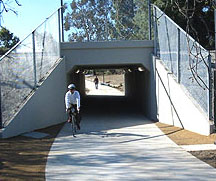 So what's the point of all this ranting? It's a one-woman message to the traffic engineers and bureaucrats involved in designing these bridges, tunnels, etc.:
So what's the point of all this ranting? It's a one-woman message to the traffic engineers and bureaucrats involved in designing these bridges, tunnels, etc.: When you design and build any bicycle facility, please, please THINK!
Think about summer sun, winter rain and other weather effects. Will they deteriorate the surface? How steep a grade should it have? Could a child on training wheels negotiate it? Is there enough room for pedestrians and cyclists to pass each other going in opposite directions? How about two directions of traffic with multiple users going in the same direction? How will installing posts or other barriers affect use? Could a tandem pass through? How about a recumbent, or a fully loaded touring or mountain bike? (Hint: panniers stick out, for a much wider profile.)
You can do more than just think about these issues. Here's a novel concept: Get on a bike yourselves and actually ride some of your "facilities." After you've ditched a couple of times, you might just insist on putting in direct-approach ramps, easier grades and unbarriered bike lanes. The life or limb you save could be your own -- and mine!
Naomi can be reached at naomibloom@earthlink.net
